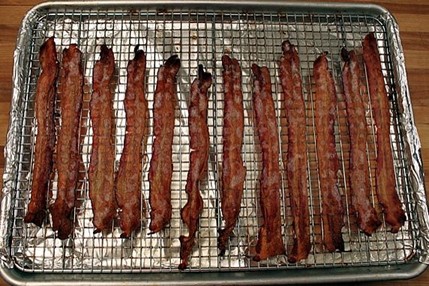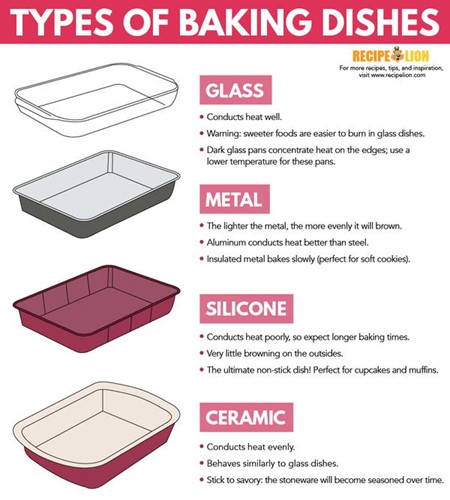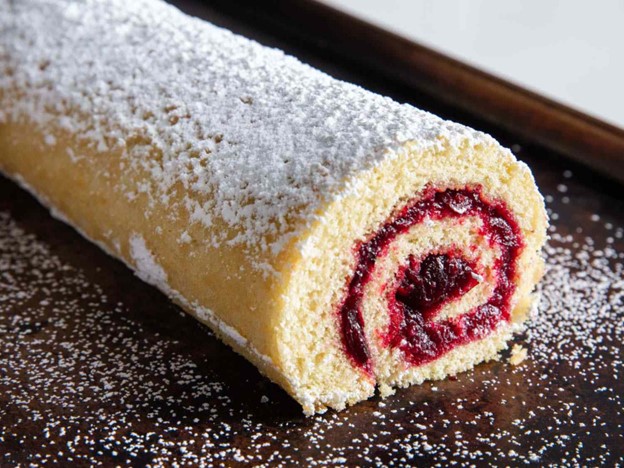The Bottom Line on Bakeware
Ever wondered what the difference is between sheet pans, cookie sheets and baking pans? Not to mention half sheets and jelly roll pans? Me too, so I thought it would be helpful to break down all the types of sheet pans, cookie sheets and baking pans for you so you're never confused about the differences again.

One typical way to decide what to buy is your available cupboard space. If you're short on this, then building a bakeware collection based on items that play several roles can be a smart way to save space. BUT, because pan performance varies with material and other intrinsic factors, you do want the right pan for the job (meaning you may end up with more pans than you have space to house). And even if you have oodles of cupboard space, do you really want or need to buy lots of pans?
What to do? Do you really need a whole bunch of different flat-ish pans to make a meal or a few batches of cookies? OR, can one pan effectively serve for many jobs? Following is research from food and cooking researcher, Emily Cappiello (of www.cnet.com) that addresses these questions.
First, BAKING SHEETS (aka SHEET PANS). One of the most multifunctional pieces of bakeware is a baking sheet. These kitchen workhorses work well in both worlds—savory (anything from roast meats and vegetables to one-pan, multilayered meals) as well as sweet (sheet cakes, bars, and layered desserts).
A baking sheet or sheet pan has a shallow outer rim around all four sides to keep juices and other liquids from being lost. Additionally, baking sheet pans play nice with accessories like roasting and cooling racks (handy for making perfect bacon, among other things).

The downside of metal baking sheets is that acidic ingredients can react to the metal. To avoid that, line the pan with parchment paper or a silicone mat when cooking such items. In fact, this is an excellent habit when baking anything because clean-up is so much easier.
They come as quarter sheet pans, half sheet pans and full sheet pans (or commercial sheet pans). Quarter pans are typically 9 x 13 inches (a standard sheet cake size), half pans are 18 x 13 inches (the size of most pans described simply as baking sheets) and full sheet pans are 26 by 18 inches (standard commercial size—too big to fit in many home ovens).

These pans are typically manufactured from heavy-gauge aluminum, stainless steel, anodized aluminum, and silicone with reinforced rims.
Next, BAKING PANS. This is where things get interesting. Baking pans are different from baking sheets because they're deeper and come in a wider range of shapes and sizes. Also, their material range is broader. You’ll find them made from ceramic, stoneware, metal, glass, and reinforced silicone.

The most common baking pan shapes are rectangular and square. Rectangles are usually 9 x 13 inches, and the most common size for a square is 8 x 8 or 9 x 9 inches.
Because of their depth, baking pans are perfect for cake batter and savory dishes that contain sauces (think casseroles, lasagnas and cobblers).
Then there’s COOKIE SHEETS. Unlike baking sheets, these don’t have raised sides. A side-less pan ensures that cookies will bake evenly and will be easier to remove from the pan with a spatula. (That said, you know very well that you can definitely bake cookies on a sheet pan.)

Traditional cookie sheets have small lips on just one edge for gripping when sliding them in and out of the oven. They come in a variety of shapes, sizes, and thicknesses. And they come as insulated, nonstick, aluminum, and stainless steel.
Lastly, JELLY ROLL PANS. There’s not a lot of difference between these and baking sheets. They have 1-inch sides and were created for baking thin sheet cakes meant specifically for use in jelly rolls. The jelly roll pan can also be used for baking bar-type cookies. In reality, a jelly roll pan nothing more than a smaller version of a baking sheet, so if you have one of those, you don't need a jelly roll pan too.

So after all this, what are the answers to the above-asked questions? NO, you don’t need a bunch of flat-ish pans for different baking jobs. A sheet pan works just fine for everything but casseroles and layer cakes. And a 9 x13 baking pan works great for cakes, casseroles, bars, and layered desserts. Same with a square baking pan. If you’re low on cupboard space, 1 sheet pan and a 9 x 13 baking pan will suffice. For convenience you might also add the square baking pan.
Just know that if you opt for glass baking pans, you’ll need to bake your dish a little longer than if you were using a metal pan. Also, if you bake for lots of people, a half-sheet might not be the best choice—choose the bigger sheet pan. And that’s the bottom line on bakeware.
blog comments powered by Disqus

One typical way to decide what to buy is your available cupboard space. If you're short on this, then building a bakeware collection based on items that play several roles can be a smart way to save space. BUT, because pan performance varies with material and other intrinsic factors, you do want the right pan for the job (meaning you may end up with more pans than you have space to house). And even if you have oodles of cupboard space, do you really want or need to buy lots of pans?
What to do? Do you really need a whole bunch of different flat-ish pans to make a meal or a few batches of cookies? OR, can one pan effectively serve for many jobs? Following is research from food and cooking researcher, Emily Cappiello (of www.cnet.com) that addresses these questions.
First, BAKING SHEETS (aka SHEET PANS). One of the most multifunctional pieces of bakeware is a baking sheet. These kitchen workhorses work well in both worlds—savory (anything from roast meats and vegetables to one-pan, multilayered meals) as well as sweet (sheet cakes, bars, and layered desserts).
A baking sheet or sheet pan has a shallow outer rim around all four sides to keep juices and other liquids from being lost. Additionally, baking sheet pans play nice with accessories like roasting and cooling racks (handy for making perfect bacon, among other things).

The downside of metal baking sheets is that acidic ingredients can react to the metal. To avoid that, line the pan with parchment paper or a silicone mat when cooking such items. In fact, this is an excellent habit when baking anything because clean-up is so much easier.
They come as quarter sheet pans, half sheet pans and full sheet pans (or commercial sheet pans). Quarter pans are typically 9 x 13 inches (a standard sheet cake size), half pans are 18 x 13 inches (the size of most pans described simply as baking sheets) and full sheet pans are 26 by 18 inches (standard commercial size—too big to fit in many home ovens).

These pans are typically manufactured from heavy-gauge aluminum, stainless steel, anodized aluminum, and silicone with reinforced rims.
Next, BAKING PANS. This is where things get interesting. Baking pans are different from baking sheets because they're deeper and come in a wider range of shapes and sizes. Also, their material range is broader. You’ll find them made from ceramic, stoneware, metal, glass, and reinforced silicone.

The most common baking pan shapes are rectangular and square. Rectangles are usually 9 x 13 inches, and the most common size for a square is 8 x 8 or 9 x 9 inches.
Because of their depth, baking pans are perfect for cake batter and savory dishes that contain sauces (think casseroles, lasagnas and cobblers).
Then there’s COOKIE SHEETS. Unlike baking sheets, these don’t have raised sides. A side-less pan ensures that cookies will bake evenly and will be easier to remove from the pan with a spatula. (That said, you know very well that you can definitely bake cookies on a sheet pan.)

Traditional cookie sheets have small lips on just one edge for gripping when sliding them in and out of the oven. They come in a variety of shapes, sizes, and thicknesses. And they come as insulated, nonstick, aluminum, and stainless steel.
Lastly, JELLY ROLL PANS. There’s not a lot of difference between these and baking sheets. They have 1-inch sides and were created for baking thin sheet cakes meant specifically for use in jelly rolls. The jelly roll pan can also be used for baking bar-type cookies. In reality, a jelly roll pan nothing more than a smaller version of a baking sheet, so if you have one of those, you don't need a jelly roll pan too.

So after all this, what are the answers to the above-asked questions? NO, you don’t need a bunch of flat-ish pans for different baking jobs. A sheet pan works just fine for everything but casseroles and layer cakes. And a 9 x13 baking pan works great for cakes, casseroles, bars, and layered desserts. Same with a square baking pan. If you’re low on cupboard space, 1 sheet pan and a 9 x 13 baking pan will suffice. For convenience you might also add the square baking pan.
Just know that if you opt for glass baking pans, you’ll need to bake your dish a little longer than if you were using a metal pan. Also, if you bake for lots of people, a half-sheet might not be the best choice—choose the bigger sheet pan. And that’s the bottom line on bakeware.
 Alice Osborne
Alice Osborne
DVO Newsletter Contributor since 2006
Email the author! alice@dvo.com
Sources:
- www.thespruce.com
- www.theyummylife.com
- www.gygi.com
- www.recipelion.com
- www.radacutlery.com
- www.seriouseats.com
